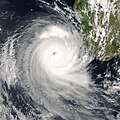Fichier:Favio 2007-02-20 1115Z.jpg
Apparence

Taille de cet aperçu : 471 × 599 pixels. Autres résolutions : 188 × 240 pixels | 377 × 480 pixels | 603 × 768 pixels | 804 × 1 024 pixels | 1 609 × 2 048 pixels | 4 400 × 5 600 pixels.
Fichier d’origine (4 400 × 5 600 pixels, taille du fichier : 4,35 Mio, type MIME : image/jpeg)
Historique du fichier
Cliquer sur une date et heure pour voir le fichier tel qu'il était à ce moment-là.
| Date et heure | Vignette | Dimensions | Utilisateur | Commentaire | |
|---|---|---|---|---|---|
| actuel | 7 septembre 2007 à 22:58 |  | 4 400 × 5 600 (4,35 Mio) | Good kitty | Reverted to version as of 22:40, 20 February 2007 |
| 23 février 2007 à 15:46 |  | 3 400 × 3 399 (1,96 Mio) | NSLE-Chacor | cropped version | |
| 21 février 2007 à 00:40 |  | 4 400 × 5 600 (4,35 Mio) | Good kitty | == Summary == {{Information |Description=Tropical Cyclone Favio formed in the western Indian Ocean about 1,200 kilometers from Madagascar on February 14, 2007. It gradually moved southwest, passing well offshore of Reunion and Mauritius Islands. By Februa |
Utilisation du fichier
La page suivante utilise ce fichier :
Usage global du fichier
Les autres wikis suivants utilisent ce fichier :
- Utilisation sur de.wikipedia.org
- Utilisation sur en.wikipedia.org
- User talk:AySz88
- User talk:Fableheroesguild
- User talk:Mkieper
- User talk:WmE
- User talk:Juan andrés
- User talk:Ev-Man
- User talk:Cyclone1
- User talk:Pobbie Rarr
- User talk:WeatherVane
- User:Bob rulz/Hurricane Herald
- User talk:Hurricane-Inu
- User talk:Ajm81/Newsletters
- User talk:Maverick423
- User:WindRunner/WPTC newsletters
- User talk:Sd31415/March 2007
- User talk:Verrai/Archive11/Archive9
- User talk:@pple/Archive 1
- User talk:Daniel/Archive/27
- Wikipedia:WikiProject Tropical cyclones/Newsletter/Archive 10
- User talk:Sean Whitton/Archive 10
- 2006–07 South-West Indian Ocean cyclone season
- User talk:Nightstallion/κ
- User talk:A7x/Archive 03
- User talk:Titoxd/Archive22
- User talk:Hurricanehink/Archive 10
- User talk:Erebus555/archive4
- User talk:The Grid/Archive 2
- User talk:Jamie C/Archive 3
- User talk:Robomaeyhem/Archive 4
- User talk:Typhoonchaser/Archive 1
- User talk:AstroHurricane001/Archive 6
- User talk:Sarsaparilla39/Archive 1
- User:Fishhead/Archive1
- User talk:IrfanFaiz/Archive/Archive No.2
- Tropical cyclones in 2007
- User talk:Icelandic Hurricane/Recent Archive
- Cyclone Favio
- Utilisation sur pt.wikipedia.org
- Utilisation sur zh.wikipedia.org


